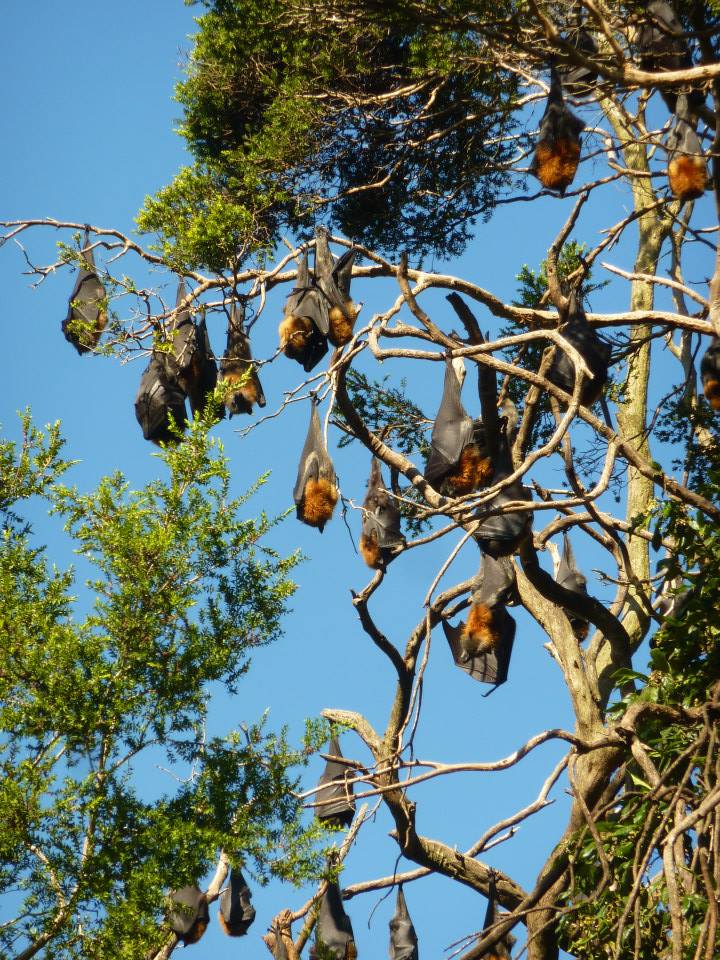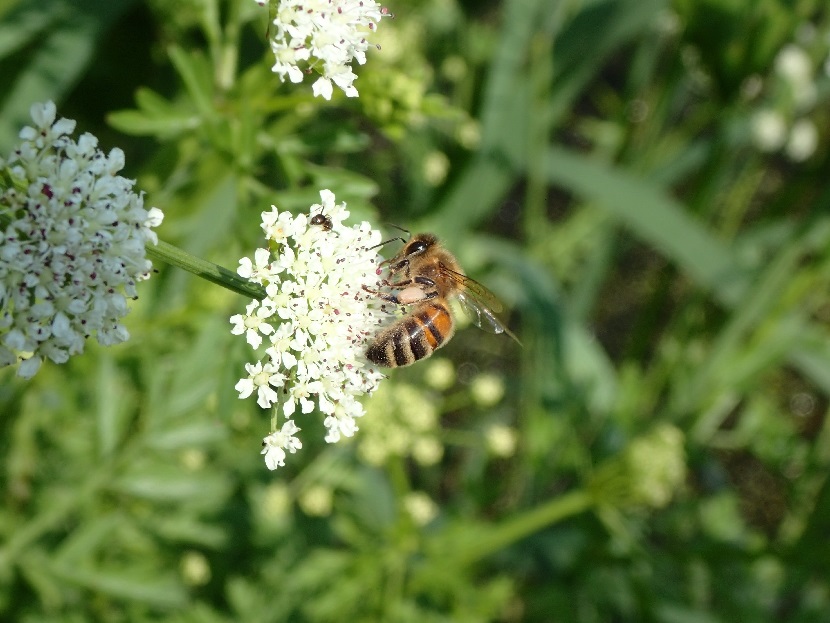Animal communication
Article curated by Ginny Smith
Animals certainly communicate - some using sounds, and others using body language, pheromones or even electricity. But does any of this actually constitute language?


Learn more about Animal language.


 2
2Apes including gorillas, silverbacks, chimps, bonobos, hum. They do this both in the wild and captivity, although more commonly in captivity. Scientists don’t know why they start humming, or how this relates to captivity, but they do think that humming apes are happy apes. Humming is more common amongst males when feeding to entice in the females and scientists think the humming can be used to determine the social structure of groups and status of individuals. Can you hum grammar?


Bats

Researchers know that they have hunting calls, often high frequency bursts that get higher as they get closer to the prey. But they also produce lower frequency calls, which scientist believe they use to talk to each other. However only around 5% of these calls have been classified, so there is still much to uncovered about the mysterious world of bat communication.
We also know that bats can recognise individual bats, and recognise whether they are a stranger, a member of their massive colony, or a member of their close family. How do they do this? We don’t know – but it could be through communication.
Learn more about Bat chat.


 2
2It's possible we're not even picking up all the bat calls. Tarsiers, often considered the quietest animals, have recently been picked up by scientists using bat detectors communicating in the ultrasonic sound range ~70kHz, more than three times the highest frequency sounds humans can pick up. Scientists are still trying to work out how their larynxes and ears are developed to work within these frequency ranges.


Ocean giants
Whale song is famous the world over for its haunting sound and ability to travel long distances. But we don't know for sure why they produce these incredible sounds. There are various hypotheses, the prevailing one being that it is for mating purposes, but it could be for more than that. Studies are now showing that baleen whales use the same songs when hunting and feeding, not just breeding. However they also use 'tick tock' noises, called paired bursts, to communicate deep underwater when hunting. The purpose of these sounds are not well understood, as it could be for luring out prey, working together to locate prey, or even as a dinner bell call for other whales nearby when prey is found. Why then, would they also sing when hunting? Is it for the same purpose, or another? Until we can speak 'whale', we may not find the answers to these questions.
Learn more about Whale Singing; Dinner or Date.


 2
2Fascinatingly, it has been found that in sperm whales' calls vary depending on the region a whale is from – they have the equivalent of accents and possibly even languages[1][2][3]. Within a group, there is also a difference between how individuals 'pronounce' a call used by all whales, known as the "five regular". Researchers think this helps members of a group identify each other – a bit like a name.


 2
2
Reports on wild sharks have documented cooperative behaviour, play behaviour, and courtship behaviour. Scientists think these behaviours demonstrate a complex level of communication between members of the species. However, behavioural understanding of shark species is “alarmingly incomplete”, and most studies have taken place in captivity.


 3
3Whilst observed behaviours suggest that sharks can communicate, some doubt remains as we have never observed them emitting sound signals. Sharks have very good eyesight, so it could be they communicate via body movements instead. Researchers believe that shark body language can actually be used to interpret their moods and predict behaviours; over fifty distinct movement patterns have been isolated in shark behaviour.
A further possibility is pheromones. Although we are not sure whether sharks use pheromones, they are a well known way of communicating throughout the animal kingdom. Sharks have a strong sense of smell and have been noticed responding to scent signals, such as being attracted or repulsed by the source of the smell, so it could be they use these chemical signals to communicate. It is even possible sharks may communicate on a cellular level by using their electroreceptors to sense the salt solution in each other’s cells. How they could intentionally send out signals like this is unclear though, so the secret nature of how sharks “talk” remains.
Learn more about Shark communication.


 2
2
The Caribbean reef squid can uses colour to communicate. It can change colour, flash, change texture and change pattern. Scientists even think Caribbean reef squid can change two different colours on two different sides to send different signals to different neighbouring squid. Scientists think these signals relate to mood, the presence of threats, and desire to mate.


Naked mole rats
Naked mole rats have a few things in common with bats and whales. They live in colonies, and have distinct languages and accents within them. Researchers have been employing machine learning to decipher patterns in the mole rat chatter, and found their chirrups, chattering, gruntles and squeaks are different pitches for different communities[4]. Researchers think that naked mole rat communication is socially learnt. They found that pups swapped between colonies learn their adoptive rather than native tongue, and more so the younger they are when they’re swapped.


The Birds
Birds have a complex and interesting language. They only use song to signal danger or seek out a mate: they can form complex sentences by stringing calls together to create new meanings and demonstrate syntax – which scientists think evolved separately in birds to in humans. For tits, the instructions “come here” followed by “scan for danger” calls the whole flock, but “scan for danger” followed by “come here” causes confusion.


 2
2Some birds use their voices to mimic other birds. No one is quite sure why they do this, especially those who mimic their predators – like the male fairy wren. He copies the call of the butcher bird. Only the male does this, and scientists think it may be to show bravado when the female fairy wren is listening carefully, wary of the predator. However, it seems strange that this would be of evolutionary advantage as it also calls the butcher birds’ attention to them and results in high mortality. Quite why it’s evolved is still a mystery.


 2
2Humans may even get psychological benefits from listening to birdsong. Research into biophilia has shown improved mood, cognitive function, self-esteem, reduction in blood pressure, positive impacts on immune function, and that people spend 20% more time talking when outdoors. Scientists don’t know why this is, but the idea is sufficiently established that Alder Hey Children’s Hospital in Liverpool play birdsong in their corridors, as does an airport lounge in Amsterdam! It’s even been applied as a form of dementia treatment – a treatment known as ecotherapy. New work currently being undertaken by the National Trust aims to explore how human brains are affected by birdsong, and potentially shed light on how bird song therapy works.


 3
3Insects



Fireflies use glowing to communicate, flashing their lights up and down a bit like Morse Code. These codes differ between species, males and females, juvenile and adult fireflies and are chemically controllable by the fireflies. Lavae use short glows at night to warn predators they contain chemicals that are not good to eat, whilst adults seem to use them to compete for mates. Scientists are working on deciphering them.


Not all animals use their voices. The deathwatch beetle, a common best in South England, destroys furniture and structural wooden beams in buildings by burrowing through them. Once inside, it sits in tunnels and bashes its head against the tunnel walls, making an irritating tapping noise famed to warn of impending death. Scientists think this tapping may be performed to attract mates. As far as they can see, it is the main form of communication between deathwatch beetles.


This article was written by the Things We Don’t Know editorial team, with contributions from Ginny Smith, Rowena Fletcher-Wood, and Joshua Fleming.
This article was first published on 2017-02-16 and was last updated on 2021-09-27.
References
why don’t all references have links?
[1] Antunes, R., et al., (2011) Individually distinctive acoustic features in sperm whale codas. Animal Behaviour 81.4:723-730. doi: 10.1016/j.anbehav.2010.12.019.
[2] Stimpert, A., et al., (2012) Humpback Whale Song And Foraging Behavior On An Antarctic Feeding Ground. Public Library of Science ONE 7.12. doi: 10.1371/journal.pone.0051214.
[3] Parks, S., et al., (2014) Evidence For Acoustic Communication Among Bottom Foraging Humpback Whales Nature 4.7508. doi: 10.1038/srep07508.
[4] A. J. Barker et al. Cultural transmission of vocal dialect in the naked mole-rat. Science. Vol. 31, January 29, 2021, p. 503. doi: 10.1126/science.abc6588.
Recent animal communication News
Get customised news updates on your homepage by subscribing to articles













